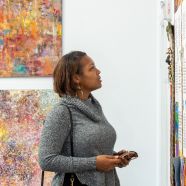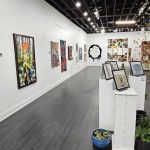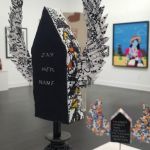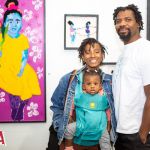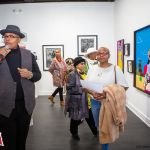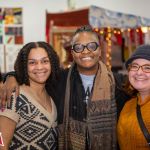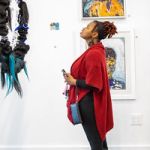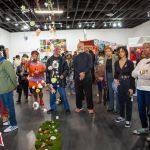This Side o’ Town: Black Art in America Reflects Upon the Community It Serves
“We’ve had a number of people talk about how our gallery rivals any they’ve ever gone to, but I was blown away by the sister who felt like something of this caliber didn’t deserve to be on this side o’ town,” recalls Najee Dorsey, founding CEO of Black Art in America Gallery & Gardens. Housed on a near-acre of land at the corner of Connally and Semmes Streets in East Point, Georgia, the popular gallery boasts a sculpture garden, event spaces, a gift shop, and a jazz deck for those residing in or visiting the Metro Atlanta area.
“That doesn’t sit well with me,” clarifies Dorsey, a well-established artist himself. Such thinking “buys into a powerful system that has done things to make Black people, people of color, and marginalized communities not feel valued and think that the only way to get to a certain level is to assimilate with others, to be in close proximity, or to be where they are,” offers Dorsey, noting, “I think that is problematic. I think people just want to be in nice spaces, they want to feel welcome, they want a sense of community, and they want to see a reflection of themselves.”
Consistently, Dorsey has created a space in a predominantly Black community with a population eager to see such artistic reflections of themselves. Three years prior to the June 2022 opening of the gallery by Black Art in America—aka BAIA (“BY-yuh”), Dorsey’s thirteen-year-old online company behind the new gallery—the city of East Point adopted its first Public Arts Master Plan, an ongoing initiative with murals and street art by and depicting African Americans throughout its revitalized downtown area.
Given this momentum, the gallery was an important cultural addition that immediately impacted the local community through the BAIA Foundation’s free community art and gardening programming for children and seniors; artist-led community workshops for local residents; artist lecture series for professional development and community education; and ongoing collaborations with local artists around important themes like health and wellness. The latter was recently exemplified by the gallery’s hosting of the exhibition, “If Only the Patchwork Could Talk,” a heart disease awareness initiative that brought twenty female survivors of traumatic medical ordeals to connect and inspire a quilted artwork with images and words reflecting their life-altering experiences. The poignant exhibit was coordinated by area artist Marvel Micheale.
“BAIA is a few blocks away from my home,” reveals Micheale, who first found out about the gallery after seeing a work of art outside the newly renovated facility. Two months later, she met Dorsey and “began to dialogue about storytelling because that is my wheelhouse, and had been for a number of years.” After Dorsey expressed an interest in her work, “we talked about previous projects and discussed ‘If Only the Patchwork Could Talk’ was something that he was interested in,” details Micheale, the “main reason being his wife had experienced some firsthand medical issues with a stroke and heart disease. So that became a project that he said, ‘Let’s do this together for the community.’”
“The amazing thing with that project and what BAIA puts together is the participation of everyday people,” continues Micheale. “When something happens to you medically, oftentimes you hide it in a secret place. But that participation allowed for the voices of people sharing their experience within an engaged and supportive community, and it was a powerful piece and a wonderful collaboration.”
Though actively promoting the arts as a municipality, it was not the city of East Point’s official leadership that enticed BAIA to East Point from its former Columbus, Georgia, headquarters. Along with its representative community demographics, Dorsey was drawn to purchase the land and former church facility in desperate need of renovation for the same three reasons most buy real estate: location, location, location.
“I actually tell people that the property found us,” offers Dorsey, of the sizable lot triangulated only by streets. “When I first came across it, I just knew from the start this could be something special. You got three corners, a good size footprint at three quarters of an acre, and good bones on the building,” noting “I tell people it’s my largest canvas to date. And we’re just constantly working to create something special that people will want to continue to come back to.”
“Black Art in America is providing a very enriching experience from the gallery to the garden, both inside and outside,” says Maceo Rogers, economic development director for the city of East Point. The colorful, art-adorned complex, promotes Rogers, “has made a difference in people’s lives because they’re now experiencing something that is unique to the city.”
But even with its local community ties and accessible location minutes away from Tyler Perry Studios, Black Art in America has always been a national phenomenon. In 2010, after experiencing the challenges of a full-time artist and conferring with a number of his artistic peers, Dorsey launched Black Art in America as a free online platform for African American artists, collectors, art enthusiasts, and arts professionals. Given the need for such a resource—one devoted to documenting, preserving, and promoting the contributions of the African American arts community—the popularity of the company soared as BAIA quickly became the most recognized platform for Black visual art in the nation. Over its thirteen-year history, BAIA has produced a massive amount of free and educational content for its tens of thousands readers, members, and social media followers in the form of podcasts, web TV, and video, with an editorial side offering news, commentary, and features on the world of visual art. It has conducted member workshops on countless subjects ranging from the politics of art to collecting, and produced fine art shows in major markets across the country, free and open to the public. It has represented works by a long roster of emerging, established, and deceased African American artists, and its popular yard-art series, Garden Art for the Soul, has become a decorative staple in the yards of thousands of African Americans throughout the nation.
The company’s national reach also comes with a local effect. “It’s going to certainly have an impact on tourism because people are coming from all over, and it provides an experience that is different from just going to a regular gallery,” says Rogers, noting how such outsiders will spend money and “add to the tax base just from their presence, without a doubt. And that makes it, all together, a beautiful thing.”
Though happy with the public reception of BAIA by the city leadership and people of East Point, Dorsey was not at all thrilled by the private economic challenges it took to be there. Upon acknowledging the aesthetics of his gallery and how it is something seldom seen in such a location, Dorsey reveals that “the challenges we had with getting the backing to do the renovation on this space didn’t make any sense. Usually in a commercial endeavor, if you’ve got 20 to 25 percent equity, you can get the funding, particularly if you have a credit score over 700. Our credit score was right at 800, we had over 50 percent equity we were looking to invest in the property, and 20 years in business, and it was a challenge to get that funding.”
So, continues Dorsey, “I look at it as, if we had trouble in our position getting resources under those conditions, what does that say about the chances for everybody else?”
Fortunately, the value of BAIA’s current location and communal reach cannot be estimated in just dollars.
BAIA offers a seasonal farmer’s market to the local community on Saturday mornings. “Talking about impact, it’s something we’ve never had, a farmer’s market of that quality right here in this community,” reveals Micheale. Micheale notes how she is quick to remind her neighbors “that Najee Dorsey could have selected a building in any of the other neighborhoods of Atlanta.”
Yet Dorsey knows exactly where he belongs.
“They want a sense of community and they want to feel respect and I think those and other things are the reason why they love BAIA and always talk about how it feels like a sacred space,” he offers, of the former church facility. “And that’s a reflection of us as it starts with my wife Seteria and myself, with the individuals that gravitate toward BAIA, and then the people that are on staff,” says Dorsey. “We all have that similar energy, so it becomes infectious.”
“When you display high culture, our art, our storytelling, and who we are as a people in a space that’s able to present it at the highest level aesthetically and in the way it’s curated, then people really appreciate that,” affirms Dorsey.
“It’s something that’s not often seen.”
**All photographs courtesy of BAIA


